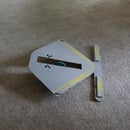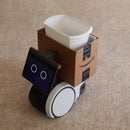Introduction: Ultracapacitor 3d Printed Flashlight
Using available parts and a 3d printer, I went from idea stage (sketch above) to a working device in one day.
Printing and designing in 3d allows a designer to build a case and mechanical parts around whatever is available. For example, I used an ultracapacitor from a Coleman Ultracap Screwdriver. It was simple to design and print a hollow cylinder to accept the capacitor--this would have been a major challenge a year ago.
Printing and designing in 3d allows a designer to build a case and mechanical parts around whatever is available. For example, I used an ultracapacitor from a Coleman Ultracap Screwdriver. It was simple to design and print a hollow cylinder to accept the capacitor--this would have been a major challenge a year ago.
Step 1:
First I printed a cylinder, scavenged the capacitor and found an LED.
I used Autodesk 123d (free) to design the 3d parts. Files are available here:
http://www.thingiverse.com/thing:31650
I used Autodesk 123d (free) to design the 3d parts. Files are available here:
http://www.thingiverse.com/thing:31650
Step 2:
Next, I came up with a plan. The LED is pretty directional, so I skipped building a reflector. The light will run for hours and hours on a charge (and I charge it with a solar panel), so I omitted the on/off switch. Note the diode--that prevents the capacitor voltage from going backwards out onto the leads; you can clip the alligator leads together if you want after charging.
If you want to see how I regulate the incoming voltage, look at this instructable:
https://www.instructables.com/id/Solar-Powered-LEDUltracapacitor-Arduino-Regulated/
If you want to see how I regulate the incoming voltage, look at this instructable:
https://www.instructables.com/id/Solar-Powered-LEDUltracapacitor-Arduino-Regulated/
Step 3:
Check to see that the capacitor fits into the cylinder.
Step 4:
Drill a 1/8 inch diameter hole in the upper part of the cylinder (yes, I should have designed that in software, but I'm far from perfect).
Step 5:
Slide the capacitor (minus any wires) into the cylinder.
Step 6:
Add a 100 ohm resistor to the long lead of the LED (I soldered it).
Step 7:
Add a red wire wrap wire to the other end of the resistor.
Step 8:
Clip the surplus wire from the resistor and put a piece of heat shrinkable tubing over the exposed metal.
Step 9:
Heat the tubing until it shrinks (I use the soldering iron to shrink the tube).
Step 10:
Add blue wire wrap wire to the short leg of the LED.
Step 11:
Clip the excess LED leg, add heat shrink and shrink the tubing.
Step 12:
Push the wire end of the alligator clips through the hole in the cylinder.
Step 13:
Push the LED leads through the cap (it's not really a reflector).
Step 14:
Connect the red LED lead to the red alligator clip.
Step 15:
Connect the diode (end without the band) and blue LED lead to the negative post on the capacitor (there's a big "-" next to the post on this particular unit).
Step 16:
Connect the black alligator clip wire to the band end of the diode.
Step 17:
Connect the red LED/alligator wire to the positive side of the ultracapacitor.
Step 18:
Test the flashlight--it's easier to correct problems now--before it's closed up.
Step 19:
Use aluminum duct tape to fasten the top cap to the cylinder--this is easy to remove if you ever want to go inside. You can use acetone or superglue to "weld" the parts together, but I prefer easy access in case I want to go inside.
Step 20:
I'm looking at it now, 5 hours after assembly--and it's still shining brightly with no indication of decreased light.

Second Prize in the
3rd Annual Make It Stick Contest

Participated in the
3D Design Contest











